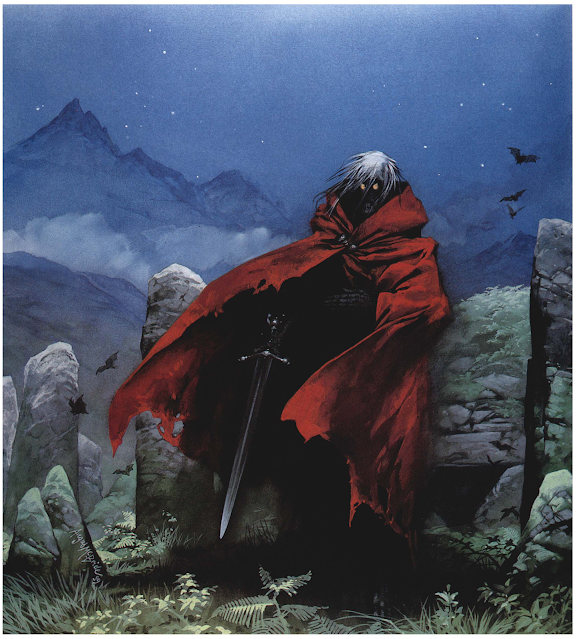One reason why I have such affection for Iron Crown Enterprise’s line of Middle-earth campaign and adventure modules, is that I learned how to run genuine “sandbox” campaigns (decades before that term was a thing) by using them. This was during the mid-late 1980s, when TSR increasingly released “story-driven” modules like their Dragonlace series. Somewhat ironically, given their literary source, the Middle-earth campaign and adventure modules typically were quite open-ended and location-based in nature, not at all focused on a predetermined “plot” or necessary sequence of events. (The one exception of which I know, and which was published quite late in ICE’s Middle-earth tenure, is their Palantir Quest ‘adventure path’.)
What happened in my Middle-earth games back in the day, essentially, is that the players would create characters in Esgaroth, Bree, Tharbad, or wherever. I would contrive some reason why they all knew each other (usually something like: “you meet at an inn and intuit that you’re all solid, trustworthy fellows looking for adventure and to protect the free peoples of Middle-earth”). The characters then would simply wander around, following whichever adventure hooks they liked. While I added hooks, encounters, and adventures to what was provided in the Middle-earth campaign modules, the books typically provided very solid frameworks for such campaigns. Or at least the ones that I used did so. As I think I’ve mentioned before here, I ran a summer-long campaign during high-school (we probably played at least 12 hours every week in those halcyon days) using the Rangers of the North (Arthedain) book, building on the adventure notes in the back (years later, these notes would be expanded by ICE into their Palantir Quest book).
I learned a lot from using ICE’s Middle-earth campaign modules. Indeed, trying to figure out how to use them, and doing what I could as a teenager to run challenging and fun sessions in a Middle-earth “sandbox” was a formative experience. (Beyond gaming, I think running MERP helped me to learn how to “think on my feet” far more than running D&D/AD&D adventures – whether published modules or my own creations – ever did.)
Yes, the books varied in quality – well, not the maps by Pete Fenlon or the covers by Angus McBride, which were always amazing. And yes, some didn’t really belong in Middle-earth, like the (totally awesome) Court of Ardor. Nonetheless, overall, I loved MERP, and I still do to this day. Hence my present joy in running the MERP-influenced Against the Darkmaster, both in 20th century Eriador (“Against the Witch-King”) and in my “homebrew” world of Urkasia (“Against the Court of Urdor”).
[This post is a modified version of a comment I posted over at the blog Grognardia, in response to a rather negative, but not unfair, review of the original Iron Crown Middle-earth module, Southern Mirkwood.]
[The pictures are by the great Angus McBride. The top one is from the cover of the Lost Realm of Cardolan campaign module, the bottom one is from the cover of the Rogues of the Borderlands adventure module.]



I've always been in awe when looking at the above McBride's picture. The desperate fighting, back to the old stones, the last sword stroke in front of an Olog Hai ... incredible painting.
ReplyDeleteYes, it's one of my favourites!
DeleteMy first sandbox campaign was Runequest's Glorantha, which was quite a bit less detailed and more mysterious back in the 80s. Still exotic today, but you're more likely to run into someone who'll tell you you've gotten some obscure myth "wrong" in defiance of the "my Glorantha is different" admonitions to the contrary.
ReplyDeleteMERP was a great choice for a sandbox too, in the same way the Star Wars universe is fun when you studiously ignore most canon and stay well clear of the major characters and their increasingly incoherent plotline. A Middle Earth where you never meet a character from the books is my idea of good time.
Even though the ICE books were set (usually) in 1640 of the Third Age, I normally ran my campaigns in the early Fourth Age in order to have some freedom with respect to canon. At one point I mapped out the history of Fourth Age until the year 500 or so, although my main campaigns were set during the first century (iirc, one character was even the son of Faramir and Eowyn, and another the son of Samwise Gamgee).
DeleteI played very little RQ back in the early days -- just Apple Lane (iirc). But the Pavis, Big Rubble, and Gryphon Mountain box sets always intrigued me. Alas, I only had so much $$$ to spend, and AD&D and MERP got most of it. However, I did get into Stormbringer and Hawkmoon around 1988-1990, which I could "grok" better than Glorantha (being a huge Moorcock fan at the time).
We had a couple of good years with Stormbringer back in the day too, mostly sandboxing in the Young Kingdoms and then going through Rogue Mistress and shifting gears into some reality-hopping - including stops in Hawkmoon, Thieves' World and Gloratha and Villains & Vigilantes of all things.
DeleteChaosium got a lot of my money in the 80s, probably more than any other RPG publisher except TSR.